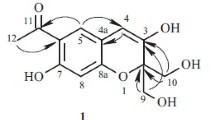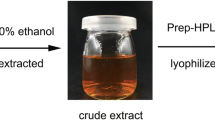Summary
The purple pigment of the gorgonianParamuricea chamaeleon has been isolated and identified as linderazulene (I).
Similar content being viewed by others
References
K. Takeda and W. Nagata, Chem. pharm. Bull., Tokyo1, 164 (1953).
K. Takeda, H. Minato and M. Ishikawa, J. chem. Soc.1964, 2591.
For other azulene NMR data see D. Meuche, B. B. Molloy, D. H. Reid and E. Heilbronner, Helv. chim. Acta46, 2483 (1963).
D. Meuche and S. Huneck, Chem. Ber.99, 2669 (1966).
A. D. Harmon, K. H. Weisgraber and U. Weiss, Experientia36, 54 (1980).
B. M. Howard and W. Fenical, Tetrahedron Lett.1978, 2453.
Author information
Authors and Affiliations
Additional information
We thank Dr K. Takeda for linderazulene spectra, and NATO for a grant (to S.I. and R.H.T.) in support of this work.
Rights and permissions
About this article
Cite this article
Imre, S., Thomson, R.H. & Yalhi, B. Linderazulene, a new naturally occurring pigment from the gorgonian Paramuricea chamaeleon. Experientia 37, 442–443 (1981). https://doi.org/10.1007/BF01986120
Published:
Issue Date:
DOI: https://doi.org/10.1007/BF01986120




